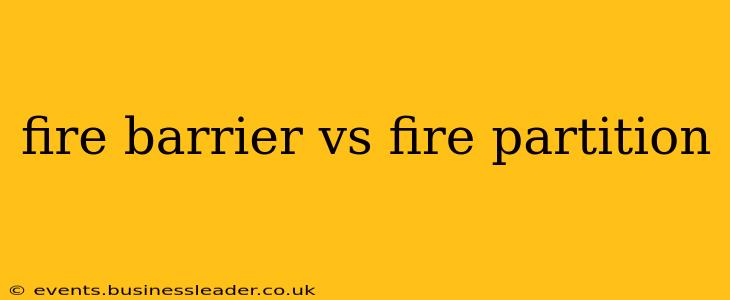Choosing the right fire protection system for your building is crucial for ensuring the safety of occupants and minimizing property damage in the event of a fire. Two common components often considered are fire barriers and fire partitions. While both aim to restrict the spread of fire, they differ significantly in their construction, performance, and applications. This article will clarify the distinctions between fire barriers and fire partitions, answering common questions and providing a comprehensive understanding of their roles in fire safety.
What is a Fire Barrier?
A fire barrier is a fire-resistant assembly designed to prevent the spread of fire and smoke through a building's structure. It's a more robust and substantial form of fire protection compared to a fire partition. Fire barriers are typically constructed from materials with high fire-resistance ratings, like concrete, masonry, or specialized fire-rated gypsum boards, often incorporating fire-rated doors and seals. They are designed to withstand intense heat and flames for extended periods, providing significant protection against fire spread. The primary function of a fire barrier is to compartmentalize a building, creating separate fire zones that limit the potential impact of a fire.
What is a Fire Partition?
A fire partition, on the other hand, offers a lower level of fire protection than a fire barrier. While still designed to restrict fire spread, its fire-resistance rating is typically lower. Fire partitions are often constructed using lightweight materials, such as fire-rated drywall, and may not require the same level of structural integrity as a fire barrier. They are commonly used to separate spaces within a building, such as apartments or offices, providing a degree of fire protection while maintaining a less substantial construction. Their primary goal is to slow the spread of fire, providing time for evacuation or suppression.
How do Fire Barriers and Partitions Differ in Construction?
The key differences lie in their construction and fire resistance rating. Fire barriers are typically more substantial structures, often incorporating specialized materials and construction techniques to achieve higher fire resistance ratings. Fire partitions, in contrast, use lighter materials and construction methods, resulting in a lower fire-resistance rating. This difference directly impacts their ability to withstand fire for extended periods.
What are the Fire Resistance Ratings of Fire Barriers and Partitions?
Fire resistance ratings are measured in hours and indicate the duration a construction element can withstand a standard fire test. Fire barriers generally have higher fire resistance ratings (often 2 hours or more), while fire partitions have lower ratings (often 1 hour or less). These ratings are critical in determining the appropriate level of protection for a given application.
What are the Applications of Fire Barriers and Partitions?
The choice between a fire barrier and a fire partition depends heavily on the specific application and building code requirements. Fire barriers are often used in high-rise buildings, industrial facilities, and other structures where stringent fire safety is paramount. They are commonly employed to separate different occupancy types or to create fire-rated shafts for vertical penetrations. Fire partitions, on the other hand, are frequently found in smaller buildings, apartment complexes, and office spaces, providing a basic level of fire separation between individual units or spaces.
Are there specific building codes that govern the use of fire barriers and partitions?
Yes, building codes vary by location but universally mandate the use of fire-resistant assemblies. Specific requirements for fire barriers and partitions are outlined in these codes, based on factors such as occupancy type, building height, and construction materials. Consult local building codes and relevant fire safety regulations for precise guidance.
What are some common materials used in fire barriers and fire partitions?
Common materials for fire barriers include concrete, masonry, and specialized fire-rated gypsum board assemblies. Fire partitions are often constructed from lighter materials such as fire-rated drywall. It's crucial to choose materials that meet the required fire-resistance ratings.
In conclusion, while both fire barriers and fire partitions serve the purpose of fire safety, they offer different levels of protection. Understanding their distinctions is vital for selecting the appropriate system to ensure compliance with building codes and the safety of occupants. Always consult with a qualified fire protection engineer or building inspector to determine the right solution for your specific needs.
